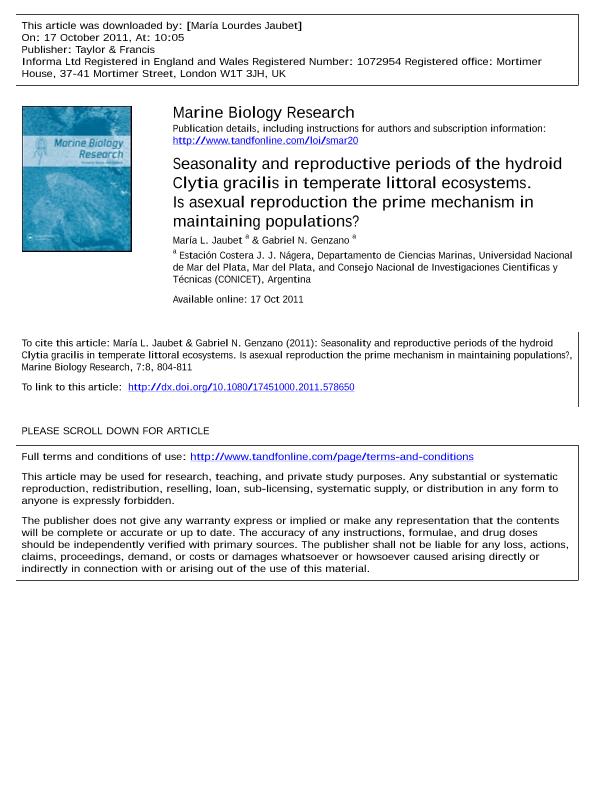Mostrar el registro sencillo del ítem
dc.contributor.author
Jaubet, Maria Lourdes

dc.contributor.author
Genzano, Gabriel Nestor

dc.date.available
2020-03-20T18:36:34Z
dc.date.issued
2011-11
dc.identifier.citation
Jaubet, Maria Lourdes; Genzano, Gabriel Nestor; Seasonality and reproductive periods of the hydroid Clytia gracilis in temperate littoral ecosystems. Is asexual reproduction the prime mechanism in maintaining populations?; Taylor & Francis; Marine Biology Research; 7; 8; 11-2011; 804-811
dc.identifier.issn
1745-1000
dc.identifier.uri
http://hdl.handle.net/11336/100445
dc.description.abstract
Hydropolyps inhabiting temperate ecosystems exhibit marked seasonality, and undergo regression as a normal part of their life cycle. In the campanulariid species Clytia gracilis, both hydroids and medusae are decidedly seasonal in occurrence. Epizoic colonies of C. gracilis, growing on colonies of Ectopleura crocea, were collected monthly in the intertidal zone at Mar del Plata, Argentina (38°08′S-57°37′W) during low tide from February 2000 to January 2001. Abundance, seasonality and reproductive periods were analysed. The hydroid reached peak abundance during the summer, yet reproductive structures were scarce and observed in only a few colonies. A remarkable regression period was evident in the cold season. During that period, hydroids of the species had few functional polyps, and the colonies were largely reduced to dormant tissue in the coenosarc of hydrocauli and stolons. Hydranths of C. gracilis regenerated during summer and produced a profuse asexual growth by stolonization. Asexual propagation is proposed as the prime mechanism in maintaining these hydroid populations. In comparisons of intertidal and subtidal populations of C. gracilis, available hydroid colonies of Amphisbetia operculata and Plumularia setacea collected from neighboring rocky outcrops (38°10′S-57°30′W), at depths of 18-20 m, during both warm and cold seasons were analysed. As in the intertidal populations, these colonies showed marked stolonal growth at the end of summer.
dc.format
application/pdf
dc.language.iso
eng
dc.publisher
Taylor & Francis

dc.rights
info:eu-repo/semantics/openAccess
dc.rights.uri
https://creativecommons.org/licenses/by-nc-sa/2.5/ar/
dc.subject
ASEXUAL PROPAGATION
dc.subject
CLYTIA GRACILIS
dc.subject
HYDROIDS
dc.subject
HYDROMEDUSAE
dc.subject
SEASONALITY
dc.subject.classification
Biología Marina, Limnología

dc.subject.classification
Ciencias Biológicas

dc.subject.classification
CIENCIAS NATURALES Y EXACTAS

dc.title
Seasonality and reproductive periods of the hydroid Clytia gracilis in temperate littoral ecosystems. Is asexual reproduction the prime mechanism in maintaining populations?
dc.type
info:eu-repo/semantics/article
dc.type
info:ar-repo/semantics/artículo
dc.type
info:eu-repo/semantics/publishedVersion
dc.date.updated
2020-03-12T15:22:28Z
dc.journal.volume
7
dc.journal.number
8
dc.journal.pagination
804-811
dc.journal.pais
Reino Unido

dc.journal.ciudad
Londres
dc.description.fil
Fil: Jaubet, Maria Lourdes. Universidad Nacional de Mar del Plata. Facultad de Ciencias Exactas y Naturales. Departamento de Ciencias Marinas; Argentina. Consejo Nacional de Investigaciones Científicas y Técnicas; Argentina
dc.description.fil
Fil: Genzano, Gabriel Nestor. Universidad Nacional de Mar del Plata. Facultad de Ciencias Exactas y Naturales. Departamento de Ciencias Marinas; Argentina. Consejo Nacional de Investigaciones Científicas y Técnicas; Argentina
dc.journal.title
Marine Biology Research

dc.relation.alternativeid
info:eu-repo/semantics/altIdentifier/doi/http://dx.doi.org/10.1080/17451000.2011.578650
dc.relation.alternativeid
info:eu-repo/semantics/altIdentifier/url/https://www.tandfonline.com/doi/abs/10.1080/17451000.2011.578650
Archivos asociados
